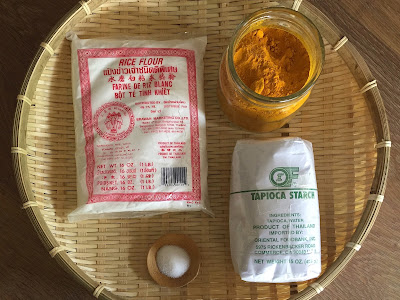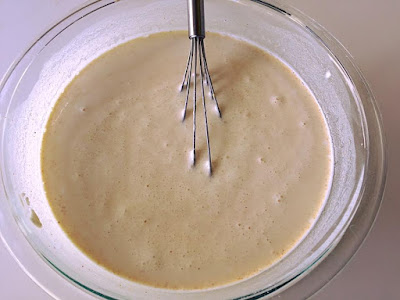A few weeks ago I made mì Quảng (Quang style noodle) again. This time, I am sharing with you a recipe on how to make fresh noodle.
The vibrant yellow noodle is called Quang style noodle. The color is the result of turmeric powder that is added to the batter. Mì Quảng is a Vietnamese noodle dish that originated from Quảng Nam province in central Vietnam. The white noodle is called bánh phở or mì (noodle) and is perfect for phở or hủ tiếu. I always have a mortar of smashed garlic, red chili pepper, and fish sauce nearby when I make this. My daughters keep coming to the kitchen and dipping the noodle into the sauce to snack on.
The vibrant yellow noodle is called Quang style noodle. The color is the result of turmeric powder that is added to the batter. Mì Quảng is a Vietnamese noodle dish that originated from Quảng Nam province in central Vietnam. The white noodle is called bánh phở or mì (noodle) and is perfect for phở or hủ tiếu. I always have a mortar of smashed garlic, red chili pepper, and fish sauce nearby when I make this. My daughters keep coming to the kitchen and dipping the noodle into the sauce to snack on.
It's true that homemade noodle takes more time to prepare than store-bought, but you are immensely rewarded with fresher, better-tasting noodle to serve with all kinds of dishes.
*
RECIPE: Fresh Rice Noodle
Ingredients
1 (16 oz) bag Rice Flour
2 tablespoons Tapioca Starch
1/2 teaspoon Salt
1 tablespoon Vegetable Oil
1 tablespoon Vegetable Oil
1 teaspoon Turmeric Powder, for Quang noodle
4 1/2 cups Water
for instructions on how to make ring and cloth
One of my blog readers bought her rice cake steamer (picture below) for $32 from Me Kong market on Capitol in San Jose, Ca. This steamer comes with two fabrics and a round metal loop.
*
Directions
Combine flour, salt, turmeric powder (if you're making Quang style noodle), water, and oil. Mix well. Set aside to rest for about half an hour to allow the batter to absorb the liquid and the air bubbles to settle before steaming.
When you're ready to steam it, steam the first one to test the consistency. If it's too thick, add a little bit more of water. How much water all depends upon your brand of flour, how old it is, and the temperature and humidly of the room.
*
Steaming Rice Cake

There are two methods of steaming rice cake.
Method #1: using a cake pan. This is my favorite method of making noodle because it's quick, easy and no mess.
If you don't have the metal ring and the fabric, another way to steam the rice cake is using the cake pan. I tested out by greasing the pan with oil. Then I also tried it without oil and it was just as easy. So no need to grease the pan.
Add water 2/3 full and stack the second layer of steamer on top. Bring it to a rapid boil.
In a cake pan, ladle about 1/4 cup of batter just enough to cover the bottom of the pan. Tilt the pan to even out the batter. The rice cake should not be too thin or too thick. Your call. Place it in the steamer; cover with a lid and steam for no longer than a minute.
In a cake pan, ladle about 1/4 cup of batter just enough to cover the bottom of the pan. Tilt the pan to even out the batter. The rice cake should not be too thin or too thick. Your call. Place it in the steamer; cover with a lid and steam for no longer than a minute.
 |
| batter without turmeric powder |
Remove the pan. To cool it down quickly, place the pan on the ice water bath while placing another pan of batter in the steamer.
 |
| My little daughter was fascinated with the process of peeling off the rice cake from the pan and so I didn't have to do this part. |

Bring the steamer to a rapid boil. Ladle about 1/4 cup of the batter onto the fabric screen. The size of the rice cake depends on the portion of the batter you pour onto the fabric screen and how big you spread the batter.
Use the bottom of the metal or coconut shell ladle like the one I used to help spread the rice batter thinly and evenly over the stretched fabric. Be sure to spread this quickly using a circular motion as the batter gets cooked very fast. Cover it up with a lid and let it steam for about 10 seconds.
Remove the lid and spread another layer of batter on top of the cooked one. The noodle needs to be thick, therefore, pouring two layers of batter is a must.
It will take a few more seconds for the steam to cook the smooth batter. The rice cake will bubble when it's ready. Use a flat and long bamboo stick to remove the rice cake, then place it directly on a cutting board.
Be sure to keep the bamboo stick in a vase of water when not using to prevent the noodle from sticking to it on the next try. Repeat the steaming process until done.
*
Making Noodle
Before cutting the rice cake, I like to brush fried garlic oil over the rice cake, then fold it up and cut into stripes. The fried garlic adds a wonderful fragrance to the noodles.
*

































This is so amazing! Thanks for sharing. I didn't know it was so simple to make your own fresh mi quang noodles.
ReplyDelete